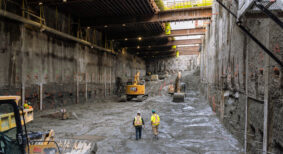British Columbia and Ontario are projected to lead construction growth in Canada, according to the labour market forecast released by BuildForce Canada.
“British Columbia is projected to lead construction growth in Canada, propelled by the start of a liquefied natural gas terminal, and transportation and infrastructure construction,” says Bill Ferreira, executive director of BuildForce Canada. “Ontario also continues to grapple with record levels of construction project activity and recruiting challenges. However, labour demands are projected to plateau or recede in most other provinces.”
BuildForce Canada’s 2019-2028 Construction and Maintenance Looking Forward nation report forecasts construction employment in Canada will strengthen modestly through 2020, as demands driven by major energy, public transportation, and other infrastructure projects rise to a near-term peak, offsetting a continued softening in housing starts.
While employment in the Canadian construction industry will see little change over the next decade, adding approximately 44,100 workers, or rising a mere four per cent, when coupled with the anticipated retirement of more than 261,000 workers, the country’s construction and maintenance industry will need to recruit an additional 300,200 workers by 2028.
For the first time since 2009, employment demand is projected to ebb after 2021, once peak project requirements are met. Slower population growth limits construction expansion nationally over the latter half of the 2019–2028 scenario period, although a period of moderate growth is expected to follow in most provinces to 2028.
Labour demands in the non-residential sector will exceed demands in the residential sector over the next 10 years.
At the end of the decade, non-residential employment is expected to increase by 35,700 jobs – an overall increase of six per cent, with gains in maintenance, and industrial, commercial, and institutional (ICI) building construction offset by modest declines in engineering construction.
Industry retirements will be an important national labour story over the coming decade. Canada’s construction industry must face the challenge of the retirement of more than 261,000 workers – 22 per cent of the current labour force. Based on historical trends, Canada’s construction industry is expected to draw in an estimated 221,300 first-time new entrants aged 30 and younger from the local population. Much of the expected entry of young workers will depend on industry’s ability to keep youth interested in the trades.
The development of skilled tradespersons in the construction industry takes years, and often requires participation in a provincial apprenticeship program. An ongoing commitment to training and apprenticeship development will be necessary to ensure there are sufficient numbers of qualified tradespeople to sustain a skilled labour force over the long term.
Building a sustainable labour force will also require the construction and maintenance industry to increase recruitment from groups traditionally underrepresented in the current construction labour force, including women, Indigenous Canadians, and new Canadians.
“Maintaining capacity to meet construction labour force needs will require focused efforts on recruiting, training, and retaining young workers, even under a slower-growth scenario,” says Ferreira. “Even if the full potential of interprovincial mobility is realized, industry will likely still need to expand recruiting efforts for new workers from local sources of labour, from other industries, and from new immigrants to meet the industry’s long-term needs.”









